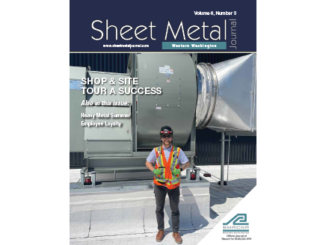
Principal Consultant and CEO
Christopher Collett and Associates Ltd.
In 2008, an article was published in Sheet Metal Journal titled SMACNA’s Indoor Air Quality Guidelines and LEED Environmental Quality Credits. 11 years later, it’s time for an update!
In 2008, the Leadership in Energy and Environmental Design (LEED) Green Building Rating System at that time for new construction and major retrofits was titled LEED NC-1.0. Since then, there have been several revisions and updates, including LEED 2009; a major change with the introduction of LEED Version 4 (known as LEED v4) in 2016; and most recently, the release of LEED v4.1 in January 2019.
These various versions of LEED have pushed the global green building market progressively, with over 90,000 registered and certified projects and more than 19 billion square feet of space worldwide.
LEED continues to provide a benchmark for the design, construction and operation of high-performance green buildings, and promotes a whole-building approach to sustainability. LEED v4.1 now recognizes performance in eight key areas: (1) location and transportation; (2) sustainable sites; (3) water efficiency; (4) energy and atmosphere; (5) materials and resources; (6) indoor environmental quality; (7) integrative project planning and design; and (8) innovation.
LEED Certification continues to be based on the total point score achieved, following an independent review and an audit of selected credits. There are four levels of LEED certification: Certified, Silver, Gold and Platinum. Successful LEED projects across the United States are frequently highlighted on the USGBC website at www.usgbc.org
Even as LEED requirements have changed with each revision, a SMACNA publication continues to play a key role in obtaining one of the Environmental Quality (EQ) Credits. In LEED v4.1, the stated intent of the EQ credit titled Construction IAQ Management Plan During Construction is “to promote the well-being of construction workers and building occupants by minimizing indoor air quality problems associated with construction and renovation”.
In LEED v4.1, to achieve this EQ credit, the following requirement is specified:
During construction, meet or exceed all applicable recommended control measures of the Sheet Metal and Air Conditioning National Contractors Association (SMACNA) IAQ Guidelines for Occupied Buildings under Construction, 2nd edition, 2007, NSI/SMACNA 008 2008, Chapter 3.
Chapter Three in the SMACNA IAQ Guideline describes a series of control measures to help minimize contamination of a building from construction activities. These include HVAC System Protection; Source Control; Pathway Interruption; Housekeeping; and Scheduling.
The primary goal of HVAC Protection is to prevent construction debris from entering the ductwork and spaces. To achieve this, the return side of the HVAC system should be isolated during heavy construction or demolition. At times when the HVAC system has to be operated during construction, temporary filters should be installed, and replaced just prior to occupancy.
Source Control is achieved through the selection of low emission materials and finishes including paints, sealants, adhesives, carpeting, other furnishings, and cleaning products. There are an ever-increasing number of low-emission products available in the construction industry.
Pathway Interruption is an important strategy to prevent the migration of contaminants through a building during construction. Approaches can include ventilation using 100% outside air during installation of Volatile Organic Compound (VOC) emitting materials and erecting physical barriers between work areas and non-work areas.
Housekeeping should be standard practice in all projects, with frequent cleaning to remove construction dust and debris, immediate clean-up of any spills, removal of accumulated water, and other actions to keep work areas dry to prevent the potential for the growth of microbial contaminants.
Careful Scheduling of the sequence of construction can minimize the absorption of VOC’s by other building materials that can act as “sinks”. For example, paints, sealants and other volatile materials should be applied and allowed to dry before ceiling tile and carpets are installed.
While the SMACNA IAQ Guideline provides the framework to achieve the LEED v4.1 EQ credit for Construction IAQ Management, successful application of the credit requires clear documentation of the IAQ Management Plan, and effective communication of the practical management procedures to the trades working throughout the construction process. In successful projects, on-going review of these construction related IAQ issues is included as part of the regular commissioning meetings.
The current SMACNA IAQ Guideline is available for purchase on the SMACNA website at www.smacna.org/bookstore



